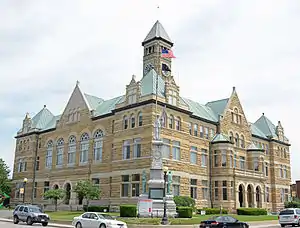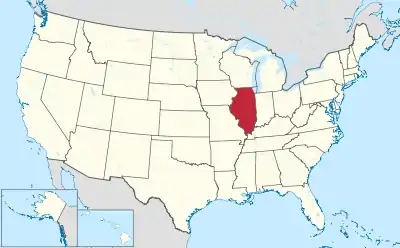Coles County, Illinois
Coles County is a county located in the U.S. state of Illinois. As of the 2010 census, the population was 53,873.[1] Its county seat is Charleston,[2] which is also the home of Eastern Illinois University.
Coles County | |
|---|---|
 | |
 Location within the U.S. state of Illinois | |
 Illinois's location within the U.S. | |
| Coordinates: 39°31′N 88°13′W | |
| Country | |
| State | |
| Founded | December 25, 1830 |
| Named for | Edward Coles |
| Seat | Charleston |
| Largest city | Charleston (population) Mattoon (area) |
| Area | |
| • Total | 510 sq mi (1,300 km2) |
| • Land | 508 sq mi (1,320 km2) |
| • Water | 1.8 sq mi (5 km2) 0.4% |
| Population (2010) | |
| • Total | 53,873 |
| • Estimate (2018) | 50,885 |
| • Density | 110/sq mi (41/km2) |
| Time zone | UTC−6 (Central) |
| • Summer (DST) | UTC−5 (CDT) |
| Congressional district | 15th |
| Website | www |
Coles County is part of the Charleston-Mattoon, IL Micropolitan Statistical Area.
History
Coles County was organized on December 25, 1830 out of Clark and Edgar counties. It was named after Edward Coles,[3] the second governor of Illinois, from 1822 to 1826. The majority of the American settlers who founded Coles County, Illinois were either from the six New England states, or were born in upstate New York to parents who had moved to that region from New England shortly after the American Revolution. This population was referred to as "Yankee" settlers, meaning that they were descended from the English Puritans who settled New England in the 1600s. They were part of a wave of New England farmers who headed west into what was then the wilds of the Northwest Territory during the early 1800s. Most of them arrived as a result of the completion of the Erie Canal. When the "Yankee" settlers originally arrived in the area, there was nothing but dense virgin forest and wild prairie. The settlers laid out farms, constructed roads, erected government buildings and established post routes. They brought with them many of their "Yankee" New England values, such as staunch support for abolitionism as well as a passion for education and the subsequent construction of many schools. They were mostly members of the Congregationalist Church, though some were Episcopalian. Due to the second Great Awakening many of them had either become Baptists or converted to denominations such as Methodism or Presbyterianism before moving to what is now Coles county. The prevalence of New Englanders and New England transplants from upstate New York made Coles county culturally continuous with the culture of New England for the first several decades of its history, this resulted in the county having a large amount of support for the abolitionist movement during the decades preceding the Civil War, and correspondingly a strong support for the Republican party. Relatively large amounts of German immigrants arrived in Coles County beginning in 1849, these immigrants were also almost unanimously abolitionists. There was a small portion of the county who were Irish Catholic immigrants, Illinois Senator Stephen Douglas was extremely popular in this community, and during the Civil War the Irish Catholic community of Coles County would overwhelmingly be copperheads.[4][5][6][7]
 Coles County from the time of its creation to 1843
Coles County from the time of its creation to 1843 Coles County between 1843 and 1859
Coles County between 1843 and 1859 Coles County reduced to its current size in 1859 by the creation of Douglas County
Coles County reduced to its current size in 1859 by the creation of Douglas County
Folklore
Coles County is home to several well-known legends and folktales, including the Mad Gasser of Mattoon and the ghost of Mary Hawkins at Pemberton Hall. Michael Kleen has documented many of these tales, including the "witch's grave" of St. Omer Cemetery and story of "Rag Doll Cemetery," in his book Tales of Coles County, Illinois.[8][9] The legend of "Rag Doll Cemetery" formed the basis of the independent film Rag Doll, which was filmed primarily in and around Mattoon, Illinois in 2010.[10] Additionally, the novel A Family Possessed by L. W. Stevenson is based on poltergeist activity experienced by a rural family living in Coles County in the 1980s.[11] Ashmore Estates has long been a part of local folklore. Originally the almshouse at the Coles County Poor Farm, it is now a haunted attraction and a place of interest for paranormal investigators.[12]
Geography
According to the U.S. Census Bureau, the county has a total area of 510 square miles (1,300 km2), of which 508 square miles (1,320 km2) is land and 1.8 square miles (4.7 km2) (0.4%) is water.[13]
Climate and weather
| Charleston, Illinois | ||||||||||||||||||||||||||||||||||||||||||||||||||||||||||||
|---|---|---|---|---|---|---|---|---|---|---|---|---|---|---|---|---|---|---|---|---|---|---|---|---|---|---|---|---|---|---|---|---|---|---|---|---|---|---|---|---|---|---|---|---|---|---|---|---|---|---|---|---|---|---|---|---|---|---|---|---|
| Climate chart (explanation) | ||||||||||||||||||||||||||||||||||||||||||||||||||||||||||||
| ||||||||||||||||||||||||||||||||||||||||||||||||||||||||||||
| ||||||||||||||||||||||||||||||||||||||||||||||||||||||||||||
In recent years, average temperatures in the county seat of Charleston have ranged from a low of 19 °F (−7 °C) in January to a high of 88 °F (31 °C) in July, although a record low of −27 °F (−33 °C) was recorded in January 1994 and a record high of 110 °F (43 °C) was recorded in July 1936. Average monthly precipitation ranged from 2.20 inches (56 mm) in January to 4.65 inches (118 mm) in July.[14]
Adjacent counties
- Douglas County - north
- Edgar County - northeast
- Clark County - southeast
- Cumberland County - south
- Shelby County - southwest
- Moultrie County - west
Major highways
Demographics

| Historical population | |||
|---|---|---|---|
| Census | Pop. | %± | |
| 1840 | 9,616 | — | |
| 1850 | 9,335 | −2.9% | |
| 1860 | 14,203 | 52.1% | |
| 1870 | 25,235 | 77.7% | |
| 1880 | 27,042 | 7.2% | |
| 1890 | 30,093 | 11.3% | |
| 1900 | 34,146 | 13.5% | |
| 1910 | 34,517 | 1.1% | |
| 1920 | 35,108 | 1.7% | |
| 1930 | 37,315 | 6.3% | |
| 1940 | 38,470 | 3.1% | |
| 1950 | 40,328 | 4.8% | |
| 1960 | 42,860 | 6.3% | |
| 1970 | 47,815 | 11.6% | |
| 1980 | 52,260 | 9.3% | |
| 1990 | 51,644 | −1.2% | |
| 2000 | 53,196 | 3.0% | |
| 2010 | 53,873 | 1.3% | |
| 2018 (est.) | 50,885 | [15] | −5.5% |
| U.S. Decennial Census[16] 1790-1960[17] 1900-1990[18] 1990-2000[19] 2010-2013[1] | |||
As of the 2010 United States Census, there were 53,873 people, 21,463 households, and 11,963 families residing in the county.[20] The population density was 106.0 inhabitants per square mile (40.9/km2). There were 23,425 housing units at an average density of 46.1 per square mile (17.8/km2).[13] The racial makeup of the county was 92.9% white, 3.8% black or African American, 1.0% Asian, 0.2% American Indian, 0.6% from other races, and 1.5% from two or more races. Those of Hispanic or Latino origin made up 2.1% of the population.[20] In terms of ancestry, 25.6% were German, 16.4% were Irish, 11.1% were American, 10.0% were English, 3.4% were Polish, 2.9% were Italian, 2.5% were French, 2.1% were Dutch and 1.9% were Scots-Irish.[21]
Of the 21,463 households, 25.5% had children under the age of 18 living with them, 41.8% were married couples living together, 9.9% had a female householder with no husband present, 44.3% were non-families, and 31.4% of all households were made up of individuals. The average household size was 2.30 and the average family size was 2.87. The median age was 31.6 years.[20]
The median income for a household in the county was $36,457 and the median income for a family was $54,170. Males had a median income of $38,915 versus $28,781 for females. The per capita income for the county was $20,601. About 10.6% of families and 20.3% of the population were below the poverty line, including 20.6% of those under age 18 and 5.9% of those age 65 or over.[22]
Communities

Cities
- Charleston (seat)
- Mattoon
Unincorporated Communities
Townships
Coles County is divided into these twelve townships:
Education
Politics
Coles County leans strongly towards the Republican Party in Presidential elections. Although it was carried by Illinoisian Barack Obama in 2008, the GOP regained the county in 2012 and Donald Trump won by 26 percent in 2016.
| Year | Republican | Democratic | Third parties |
|---|---|---|---|
| 2016 | 59.3% 13,003 | 33.4% 7,309 | 7.3% 1,606 |
| 2012 | 54.3% 11,631 | 43.2% 9,262 | 2.5% 544 |
| 2008 | 47.4% 10,978 | 50.6% 11,716 | 2.0% 459 |
| 2004 | 57.1% 13,015 | 42.0% 9,566 | 0.9% 199 |
| 2000 | 52.2% 10,495 | 44.3% 8,904 | 3.5% 694 |
| 1996 | 41.7% 8,038 | 46.4% 8,950 | 12.0% 2,310 |
| 1992 | 36.3% 8,098 | 42.2% 9,402 | 21.5% 4,800 |
| 1988 | 56.6% 11,043 | 42.7% 8,327 | 0.7% 134 |
| 1984 | 66.0% 14,044 | 33.6% 7,156 | 0.5% 95 |
| 1980 | 58.0% 11,994 | 32.6% 6,743 | 9.4% 1,934 |
| 1976 | 54.7% 11,021 | 42.9% 8,639 | 2.5% 502 |
| 1972 | 62.9% 13,681 | 36.7% 7,988 | 0.4% 82 |
| 1968 | 52.9% 10,449 | 37.1% 7,337 | 10.0% 1,980 |
| 1964 | 43.8% 8,878 | 56.2% 11,377 | |
| 1960 | 58.5% 12,166 | 41.5% 8,629 | 0.1% 19 |
| 1956 | 62.1% 12,436 | 37.8% 7,569 | 0.1% 10 |
| 1952 | 61.6% 12,660 | 38.3% 7,876 | 0.1% 20 |
| 1948 | 50.6% 8,638 | 49.1% 8,393 | 0.3% 53 |
| 1944 | 51.3% 9,473 | 48.4% 8,936 | 0.3% 54 |
| 1940 | 47.8% 10,528 | 51.8% 11,409 | 0.4% 77 |
| 1936 | 42.2% 8,800 | 57.2% 11,931 | 0.7% 137 |
| 1932 | 39.4% 7,313 | 59.7% 11,081 | 0.9% 165 |
| 1928 | 69.1% 11,479 | 30.5% 5,071 | 0.3% 57 |
| 1924 | 54.9% 8,342 | 36.5% 5,544 | 8.6% 1,308 |
| 1920 | 58.8% 8,563 | 39.9% 5,811 | 1.4% 200 |
| 1916 | 50.8% 8,314 | 47.5% 7,772 | 1.7% 271 |
| 1912 | 26.9% 2,263 | 41.0% 3,453 | 32.1% 2,710 |
| 1908 | 50.8% 4,388 | 45.8% 3,957 | 3.3% 287 |
| 1904 | 55.5% 4,901 | 38.9% 3,435 | 5.6% 492 |
| 1900 | 53.6% 4,706 | 44.7% 3,921 | 1.7% 152 |
| 1896 | 52.5% 4,534 | 46.1% 3,982 | 1.4% 117 |
| 1892 | 48.6% 3,693 | 47.5% 3,611 | 4.0% 300 |
Notable people
- Thomas Lincoln, father of future President Abraham Lincoln, moved to Coles County in 1831 and died there in 1851.
See also
References
- "State & County QuickFacts". United States Census Bureau. Archived from the original on July 8, 2011. Retrieved July 4, 2014.
- "Find a County". National Association of Counties. Archived from the original on May 31, 2011. Retrieved June 7, 2011.
- Gannett, Henry (1905). The Origin of Certain Place Names in the United States. Govt. Print. Off. pp. 87.
- The Yankee Exodus: An Account of Migration from New England by Stewart H. Holbrook
- The Yankee West: Community Life on the Michigan Frontier by Susan E. Gray
- Yankee Colonies across America: Cities upon the Hills by Chaim M. Rosenberg
- Bonds of Loyalty: German-American and World War I by Frederick C. Luebke, Northern Illinois University Press, 1974 - ISBN 9780875800455
- Tales of Coles County, Illinois. Black Oak Press, Illinois. 2010 [2004]. Archived from the original on July 29, 2010. Retrieved September 9, 2010.
- "Student author gets creative with Coles history". Daily Eastern News. October 28, 2005. Archived from the original on March 3, 2016.
- "Mattoon-based thriller gets a name". Journal Gazette/Times-Courier. May 14, 2010.
- "A Ghost Story of local proportions". Journal Gazette/Times-Courier. October 28, 2000.
- "TV team uses technology to root out spirits at Ashmore Estates". Times-Courier. July 20, 2008.
- "Population, Housing Units, Area, and Density: 2010 - County". United States Census Bureau. Archived from the original on February 12, 2020. Retrieved July 11, 2015.
- "Monthly Averages for Charleston, Illinois". The Weather Channel. Retrieved January 27, 2011.
- "Population and Housing Unit Estimates". Retrieved November 6, 2019.
- "U.S. Decennial Census". United States Census Bureau. Retrieved July 4, 2014.
- "Historical Census Browser". University of Virginia Library. Retrieved July 4, 2014.
- "Population of Counties by Decennial Census: 1900 to 1990". United States Census Bureau. Retrieved July 4, 2014.
- "Census 2000 PHC-T-4. Ranking Tables for Counties: 1990 and 2000" (PDF). United States Census Bureau. Retrieved July 4, 2014.
- "DP-1 Profile of General Population and Housing Characteristics: 2010 Demographic Profile Data". United States Census Bureau. Archived from the original on February 13, 2020. Retrieved July 11, 2015.
- "DP02 SELECTED SOCIAL CHARACTERISTICS IN THE UNITED STATES – 2006-2010 American Community Survey 5-Year Estimates". United States Census Bureau. Archived from the original on February 13, 2020. Retrieved July 11, 2015.
- "DP03 SELECTED ECONOMIC CHARACTERISTICS – 2006-2010 American Community Survey 5-Year Estimates". United States Census Bureau. Archived from the original on February 13, 2020. Retrieved July 11, 2015.
- Leip, David. "Dave Leip's Atlas of U.S. Presidential Elections". uselectionatlas.org. Retrieved October 31, 2018.
